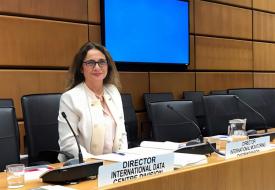Earthquake proof buildings will be designed with the ‘’Energy Principle’’
Prof. Dr.Oral Büyüköztürk (MIT Civil Engineering) and Dr. Cem Yalçın (Boğaziçi University Civil Engineering)’s joint project named ‘’Energy Based Structural Analysis of Single Degree of Freedom (SDOF) Systems by Shake Table Tests’’ is taking place within the MITSI programme funded by the Limak Foundation for three years. The project team includes the faculty members, graduate and phd students of both MIT and Boğaziçi University. Assoc. Prof. Dr. Cem Yalçın explains that the ongoing joint project between MIT and BÜ, while working within the scope of making earthquake proof buildings and to make the newly build facilities more durable against earthquakes, the buildings will be made according to ‘’energy based design.’’
He says that a suggestion by made Prof. Dr. Oral Büyüköztürk 10 years ago, had laid the foundation for the project. It was his suggestion that made them come up with Energy Based Design (EBD) by collecting and processing data from buildings and also making quality experiments. Yalçın explains that it is possible to make more durable buildings by taking into account the duration and frequency of the earthquake. He had this to say about the method that hasn’t been used before: ‘’The methods that are being used nowadays are different from each other, from equivalent seismic load method, to frequency spectrum method, or from change of location focused methods to performance based analyses. However, the duration and frequency of the earthquake is not considered in these methods. In energy based analysis method the earthquake entry energy that is transferred to the building is being calculated cumulatively according to the shifting of the building during the earthquake. The earthquake entry energy is composed of elastic, plastic, decay and kinetic energies. To understand the level of damage is a function of how much of the energy transferred to the building is wasted. To accurately calculate the energy components is essential for energy based design methods. These calculations call for the building behavior parameters to be measured correctly.’’ Cem Yalçın insists that as long as the method is implemented successfully a new and less costly solution will be provided for the engineers in the project. He says that while the energy based design is currently out of ordinary, it will be common to see it in building design implementations in the coming decade. He continued: ‘’We are looking for the energy entering the building and while doing that we have to know the dynamic characteristics of the building. This is the information we use to design the building with. We can also decide on what kind of characteristics we want before we actually build it. We can decide if we want to the building to have absolutely no damage, or little damage. What comes first is human life. Or we can specify some displacements, we can say that we don’t want the building to move from much from that displacement, for example. In sum, we can use the Energy Based Design to disperse the earthquake energy to all of the building and we design so that the building can use at least the input energy. The most important goal is to find the input energy of the building. In the experiments we did in the İTÜ Earthquake Engineering Laboratories, we calculated the earthquake energy by using a shake table colon and putting different weights on top of it and we compared it with the data we had. This was also the first experimental study in this field. Until today all of the experiments were analytical and there wasn’t any comparative experiment done before.’’
Cem Yalçın says that compared to the past buildings, the new apartments being made within the Urban Transformation of Istanbul, are much more safe in terms of the materials and the standards. ‘’The materials used in the old buildings were very poor quality. For example, while a compression strength of the concrete should be 16MPa, we have seen materials that were 6 or 8 MPa. The equipment were rotting, the material was subpar. We have found sea sand or even seashells in the concrete. After the 1999 earthquake people learned a big lesson on the quality of the materials used. Now, in all of the new buildings there ready-mixed concrete and deformed reinforcement are being used and quality controls are done. The strength of 16MPa has doubled nowadays.
There are also performance based designs that are also more in accord with the conditions of today. But the energy based methods that we suggest are more deterministic and logical. Even if we can predict the intensity of the earthquake based on historical information we cannot predict the exact moment it will happen. But because we can guess the intensity we can find if the components of the building can exhaust the energy or not. Because the recent methods cannot calculate the time span and the frequency of the earthquake there is a risk of miscalculating the load. Our methods, in this case, can predict the building load better and can divide it to the components.











